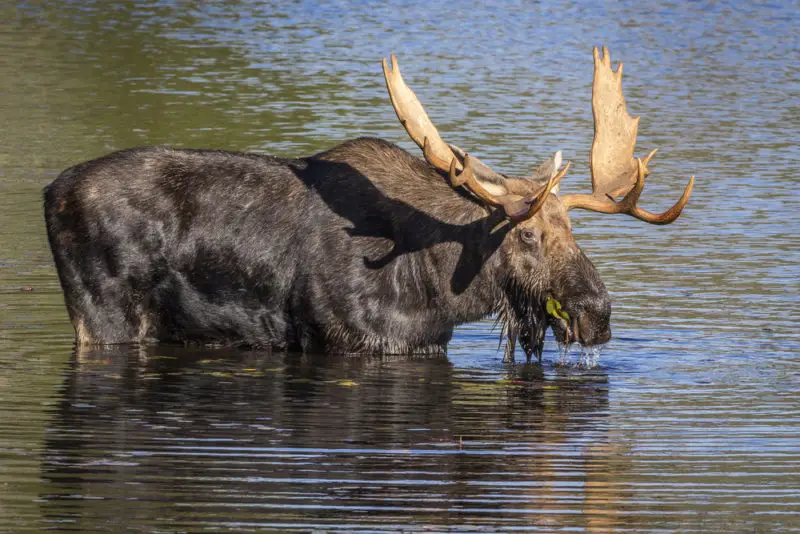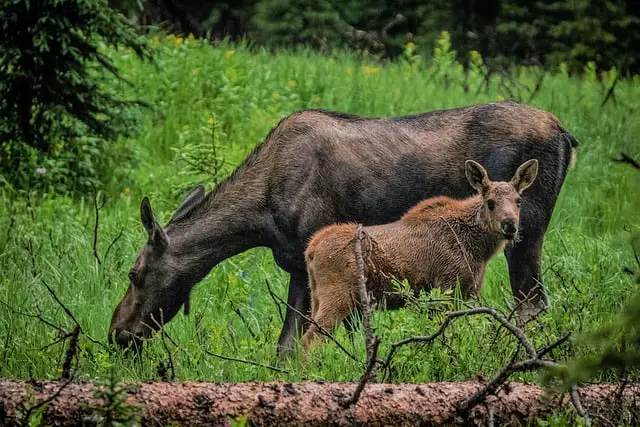According to the Vermont Fish and Wildlife Department, the green mountain state is home to around 2100 moose. The majority of Vermont moose reside in the Northeast Kingdom. Roughly half of the moose in the state live in Essex County and also in the length of the Green Mountains, from the Quebec-Canada border in the north to the Massachusetts border in the south.
Vermont, along with New Hampshire and Maine, make up northern New England. Incidentally, Northern New England is home to the largest regional moose population in the continental United States. See

History of moose in Vermont
Prior to the time of settlement by Europeans, Vermont was 95% forested. Consequently, it was outstanding habitat for moose.
As the state became more densely settled, overhunting and loss of habitat, both played a role in moose being extirpated from Vermont. By the mid-nineteenth century, only 35% of the state was still forested due to much of the wooded hillside territory being converted over to farmland. In 1899, the last moose in the state was killed in northeastern Vermont.
In the twentieth century, many of Vermont’s hillside farms were abandoned and allowed to revert back to forest. By the 1960s, around 25 moose had taken up residence in Essex County, which is in the northeastern corner of Vermont. By the 1980s, around 80% of Vermont’s area was again forested.
With the absence of natural predators such as mountain lions and wolves, Vermont’s moose population expanded rapidly.
The state of Vermont held its first modern moose hunt in 1993, in which it issued 30 hunting permits in the northeastern portion of the state.
Vermont’s moose population continued to expand, so much so that by 2007, the state offered 1252 moose permits.
Vermont’s moose population then crashed. It went from an estimated 4,800 animals in 2005 to 2,070 in 2015. Wildlife officials blame shorter, warmer winters which have led to an explosion in the number of winter ticks, for the decline. I’ll talk more about that below.
The best places for moose sightings in Vermont
According to the Vermont Agency of Natural Resources website, some of the best places to see moose in the state are around the wetlands of the northeast kingdom.
Some roads to travel as you search for a moose are route 114 between East Burke and Canaan and route 105 from Island Pond to Bloomfield.
There is also a moose observation platform at the junction of Route 105 and Notch Pond Road in Brunswick. The best time to catch moose out in the open here is mid-May through mid-July in the early morning, between 5:30 and 9:30 AM.

Limiting factors to Vermont’s moose population
Vehicle collisions
Motor vehicle collisions on Vermont highways account for 67% of all non-hunting-related fatalities in adult moose within the state.
According to wildlife biologist Nick Fortin, part of what makes these big animals so dangerous is their reaction to a perceived threat. Instead of fleeing from danger, moose tend to stand their ground when they feel threatened. Thus, if you round a bend and find a moose standing in your headlights, it’s not likely to try to flee from the road. See
Brain worms
(Parelaphostrongylus tenuis) or brain worm is a small parasitic worm that lives in white-tailed deer and moose. Because white-tailed deer evolved with the worm, it does them no harm. On the other hand, moose have traditionally lived to the north of white-tailed deer range and have only recently been exposed to the worm as deer have expanded their range northward over the last century.
A brain worm’s life cycle includes several stages. First of all, deer expel the larval stage of the worm in their droppings. Next, snails that feed on the droppings have to ingest the worm larvae and become an intermediate host for the worm.
Then in turn, a moose accidentally ingests the snails while feeding on plants that have the snails on them. The brain worm larvae then migrate along the moose’s spinal cord to its brain, destroying neural tissue and brain tissue as they go. Some of the symptoms that the moose may display are a loss of equilibrium, wandering in circles, a loss of fear, blindness, and paralysis. Most brain worm infected moose eventually die from the effects.
Winter ticks
High numbers of winter ticks (Dermacentor albipictus) weaken and deteriorate the health of adult moose. What’s more, they are a large factor in moose calf mortality. These pests specialize in parasitizing moose. The life cycle of winter ticks is different from other species of tick. Their larvae crawls onto an unfortunate host animal in the fall as it travels through thick brush or leaf litter. They then go through all three stages of their life cycle, which are larva, nymph, and adult, on the same animal through the course of the winter.
Moose, don’t lick and groom themselves as effectively as other ungulate species. Consequently, they sometimes play host to tens of thousands of winter ticks.
The impact of winter ticks in such large numbers creates blood loss that will catastrophically weaken adult moose. It’s also enough to kill young moose, particularly calves. Even if moose don’t succumb from blood loss, the irritation from all those biting ticks causes them to scratch off large patches of hair. This leaves them more vulnerable to hypothermia.
Since winter ticks specialize in feeding on moose blood, they only reach critical levels in areas where the moose density is high. After the adult drops to the forest floor and lays its eggs in areas with a lower number of available hosts, there is less chance for the continuation of their life cycle. If the larvae cannot find a host animal, the chain is broken.
In areas with lower moose densities, moose do not suffer from chronic high winter tick loads. Therefore, these pests don’t play as large a factor in overall moose health.
In 2017, Vermont Fish & Wildlife officials embarked on a three-year scientific study on the causes and effects of heavy winter tick loads on moose. The study ran concurrently with similar studies in New Hampshire and Maine.
I took the following study results from the Vermont Fish & Wildlife Department website found here.
- Moose densities greater than 1 moose per square mile support high numbers of winter ticks that impact the health of moose.
- Survival of adult moose was around 87% each year, but only 57% of adult female moose gave birth, a decline of around 50% compared to birth rates in the early 2000s.
- Only 66% of newborn calves survived their first 60 days.
- Only half of the calves (8-12 months old) survived their first winter.
- With no ticks, over 90% of calves would have survived.
Moose hunting in Vermont
The Vermont Fish & Wildlife Board manages its moose herds through wildlife management units. This allows them to either add or decrease moose permit numbers in a specific wildlife management unit depending on population objectives.
In recent years, the majority of the state has been closed to moose hunting. Last year in 2022 and also in 2021, the entire state was closed to moose hunting with the exception of Wildlife Management Unit E or WMU E, which is in the northeastern part of the state, bordering New Hampshire on the east and Canada to the north.
In WMU E, the moose population density exceeds 1 moose per square mile. Consequentially, the animals in this area are heavily infested with winter ticks. It is the goal of the Vermont Fish & Wildlife Commission to reduce the moose population density in WMU E to .75 animals per square mile and thus break the winter tick/host cycle going forward.
Moose permits are awarded through a lottery system, by the management unit. This allows the department to limit or expand the harvest numbers annually by region.
Successful applicants are allowed to designate a second shooter and a guide.
As stated earlier, for the last 2 years, 100 moose permits have been offered in wildlife management unit e. This has been the only area open to moose hunting in the state.
Vermont’s wildlife board will modify this policy when management needs to compel them to do so.
For more concise information, look here.
Recent Posts
The only venomous snakes in Washington State are Northern Pacific Rattlesnakes. The Northern Pacific Rattlesnake (Crotalus oreganus oreganus) is a sub-species of the Western Rattlesnake. Anyone...
Skunks are not classified as true hibernators. But they go into a state of torpor when the weather gets cold. Skunks are light sleep hibernators, along with opossums, bears, and raccoons. ...

